To make people sick, a pathogen faces a daunting journey of breaking through barriers, navigating the body, and evading the immune system. Though humans are constantly exposed to microbes, most don't breach the body's defenses.
In fact, a minimal dose can serve as a reminder, strengthening the body's immunity. Sickness usually occurs when a significant number of invaders overpower our defenses, turning it into a numbers game where the higher the invader count, the greater the likelihood of feeling unwell.

How Many Microbes Can Spark Illness in Humans? Understanding the Complex Journey Pathogens Face to Make Us Sick
How Do Microbes Cause Infection?
Upon entry, viruses, bacteria, or other microbes initiate infection and propagate within the body. Disease ensues as cellular damage occurs, but the likelihood of disease manifestation in those infected varies significantly, contingent upon the specific pathogen and individual susceptibility factors.
The symptoms experienced during an infection, such as fever, malaise, headache, and rash, are outcomes of the immune system's efforts to eradicate the invading microorganisms from the body.
In response to infection, the immune system becomes activated, deploying an array of components like white blood cells, antibodies, and other mechanisms to eliminate the foreign intruder. The symptoms exhibited during infection essentially reflect the immune system's dynamic activities aimed at eliminating the infectious agents.
Pathogenic microorganisms present a multifaceted challenge to the immune system. Viruses induce illness by either causing cell death or disrupting cellular functions. The body's response often involves fever, interferon secretion to impede viral reproduction, and the mobilization of antibodies and immune cells to target the invader.
Bacteria, while employing similar strategies to viruses, possess additional tactics, such as rapid multiplication, tissue disruption, and the production of toxins that can induce paralysis or trigger a severe immune reaction with toxic effects. The various strategies employed by pathogenic microbes underscore the intricate nature of the immune system's battle against infections.
How Much Microbes Does It Take To Get Sick?
The infectivity of a microbe, referred to as its "infectious dose," varies among pathogens, with some requiring only a small number of organisms to initiate an infection. For instance, norovirus, notorious for spreading in close-contact environments like cruise ships, can start an infection with as few as 18 individual viruses, making it highly transmissible.
Moreover, the concept of "viral load" is related but measures the active replication of organisms within the host, introduced during the understanding of HIV/AIDS and gaining prominence with the COVID pandemic.
Determining a microbe's infectious dose remains an inexact science. Human challenge studies, considered the gold standard, pose ethical challenges due to the risk of serious illness. Researchers often use animal models like guinea pigs, rats, mice, or ferrets, but extrapolating dosages to humans is complex.
The route of infection also influences infectious dose, with direct bloodstream entry requiring fewer microbes than those entering through the mouth or lungs.
Observational studies, tracking exposed individuals' illness onset, offer another approach to estimate infectious dose, albeit with inherent imprecision.
The variability in infectious doses among pathogens remains unclear, with suggestions that pathogens requiring direct contact with host cells tend to be more effective and have lower infectious doses. However, additional confirmation is needed across a broader range of microbes.
RELATED ARTICLE: How Microbes Evolved to Complex Life Forms on Earth?
Check out more news and information on Microbes in Science Times.














